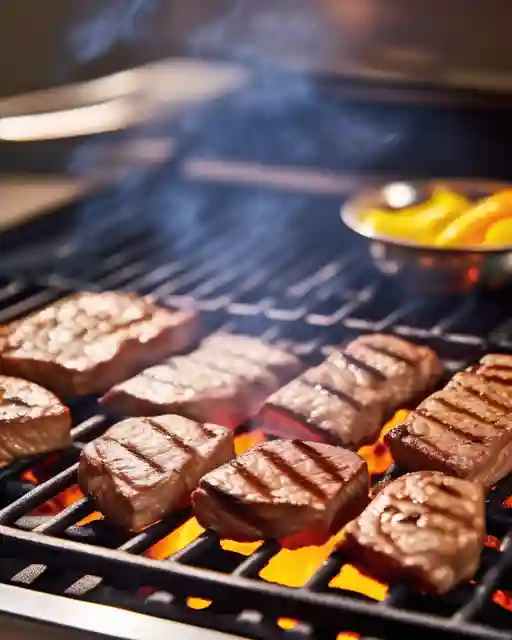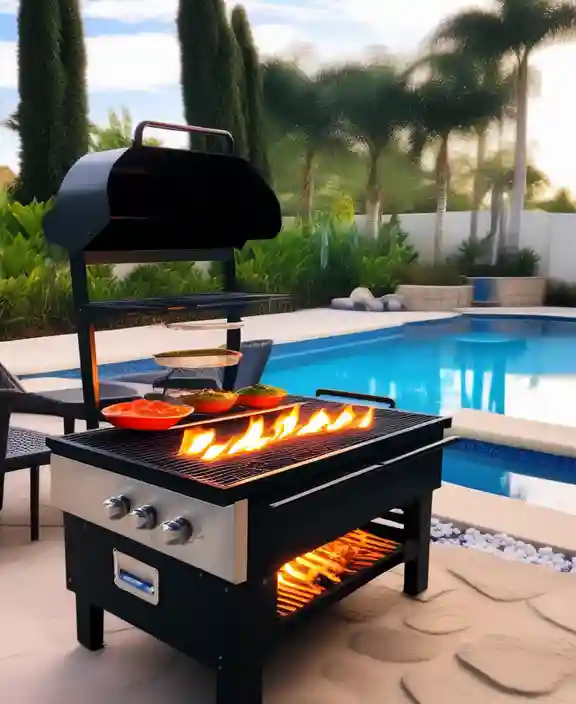Hibachi Grill vs BBQ: Finding the Better Outdoor Cooker
Updated: 24 Feb 2024
112

Firing up the grill is a beloved summer tradition for many families. But have you found yourself wondering about the key differences when it comes to a hibachi grill vs. BBQ? While both allow you to cook delicious meals outdoors, there are some significant distinctions between these two popular grilling methods.
A hibachi grill features a flat, searing hot metal surface that food cooks directly on top of. Contrast this with a BBQ, which utilizes metal grill grates raised over a heat source like charcoal or gas. Hibachi grills shine when it comes to quickly grilling meats, vegetables, and more with direct radiant heat.
Traditional BBQs are better suited for slower, smokier cooking of larger cuts of meat using indirect heat.
As we explore the hibachi grill vs. BBQ debate in more detail, you’ll discover the cooking styles, heat sources, temperature control, and other factors that set these grills apart.
Hibachi Grill vs BBQ – Which One Sizzles Better for Outdoor Cooking?

1. Cooking Surface
- Flat Hot Plate vs. Grill Grates
The cooking surfaces of hibachi grills and BBQs are quite different. A hibachi grill has a flat, super hot metal plate that you cook food directly on top of. In contrast, a BBQ has metal grill grates elevated above the heat source that the food sits on.
- Direct Contact vs. Raised Grates
With a hibachi, your steaks, vegetables, and other foods make direct contact with the scorching hot cooking surface. This allows for great searing and char marks. A BBQ keeps the food raised off the heat on those classic grill grates. The grates provide excellent grill marks but without the same direct searing.
So in summary, the main distinction is that a hibachi has one continuous flat cooking plate, while a BBQ has raised metal grill grates with spaces in between.
2. Heat Source
- Hibachi Heating Elements
Hibachi grills typically use electric or propane heating elements to generate intense heat for the flat cooking surface. These elements can quickly bring the plate up to extremely high temperatures, often over 500°F.
- BBQ Fuel Sources
In contrast, BBQs rely on charcoal, wood, or gas as fuel sources to create the heat that warms the metal grill grates. Charcoal and wood provide that classic smoky flavor as they slowly burn. Gas is convenient but doesn’t impart as much natural smoke flavor.
The heat source is a major difference between these two grill types. Hibachis use more precise and instantly hot heating elements. BBQs generate their heat through the controlled burning of various fuel sources in the grill’s firebox below the grates.
3. Cooking Styles
- Hibachi – Quick and Direct
The intense heat and flat cooking surface of a hibachi grill lends itself perfectly to quickly grilling meats, vegetables, and other foods directly on the hot plate. You can sear proteins beautifully and cook veggies fast over the extreme radiant heat.
- BBQ – Low and Slow
In contrast, BBQ grilling is ideal for low and slow smoking of larger cuts of meat like brisket, ribs, or whole chicken. The indirect heat and ability to control smoke penetration allow you to cook these bigger items over longer periods for that signature BBQ flavor.
So in summary – hibachis are rapid-fire cooking right on the scorching plate, while BBQs are all about patient, indirect low-heat smoking of larger proteins. The distinct styles match the different grill designs.
4. Temperature Control

- Hibachi Precision
One advantage of hibachi grills is their precise temperature control. Since they use electric or propane heating elements, you can easily dial in the exact desired temperature. This allows for very consistent and controlled cooking.
- BBQ Challenges
Maintaining steady grill temperatures on a BBQ can be trickier. With fuel sources like charcoal and wood, factors like airflow and fuel burning rates affect the heat levels. It takes practice to learn the vent controls to keep temperatures where you want them over long periods.
5. Portability
- Compact Hibachi Grills
One major advantage of hibachi grills is their exceptional portability. Hibachi units are typically quite small and lightweight compared to BBQ grills. This makes them easy to transport to a park, campground, or just your backyard patio.
- Hefty BBQ Grills
In contrast, BBQ grills are often much larger and can weigh hundreds of pounds. Their substantial size and heft make them less convenient for taking on the go. BBQ grills are usually designed to stay in one semi-permanent location.
The portability factor is a clear distinction between these two grill styles. Hibachis are grab-and-go for grilling anywhere, while BBQs tend to be stationary, heavy-duty outdoor kitchen units.
6. Flavors

- Hibachi – Clean and Direct
Since hibachi grills use electric or propane heating elements, they impart less of a smoky, grilled flavor to foods. The direct heat gives you nice char and searing but without that classic BBQ smokiness.
- BBQ – Signature Smoke
A defining characteristic of BBQ cooking is the amazing smoky flavor it produces. As the charcoal, wood, or gas burns, the rising smoke penetrates the meat and imparts incredible dimension and taste.
So while a hibachi will give you delicious grilled flavors, the star of a BBQ is that unmistakable smokiness. The different heat sources account for this key distinction in how the grilled foods taste. Smoke is prized in BBQ but less present with hibachi.
7. Cooking Space
- Hibachi’s Compact Surface
One limitation of hibachi grills is the relatively small and confined flat cooking area. The single hot plate provides a compact space to work with for grilling. This makes it challenging to cook large quantities at once.
- BBQ’s Expansive Grates
In comparison, the grill grates on a BBQ offer significantly more total cooking real estate. The ample grate surface area gives you the space to spread out and grill much larger volumes of food simultaneously.
So while the hibachi provides an intense direct heat, the smaller cooking zone is more suitable for smaller portion sizes and quantities. BBQs can handle catering to bigger groups and events thanks to their spacious grill grates that allow for maximum output.
Final Thoughts
There are some pretty big variations between cooking on a hibachi grill versus a classic backyard BBQ. Hibachis utilize super hot electric or propane elements to rapidly heat up a flat metal cooking plate. This intense, direct radiant heat is perfect for swiftly grilling steaks, veggies, and other foods right on the scorching surface.
BBQ grills, on the other hand, generate heat through the controlled burning of charcoal, wood, or gas underneath metal grill grates. This indirect heat is well-suited to the low and slow smoking of big cuts like brisket and ribs, allowing that signature smoky flavor to develop over time.
Beyond just the heat sources, we looked at other key contrasts – like hibachis providing ultra-precise temperature controls compared to the trickier air vents on BBQs. And hibachi grills are far more portable than their bulky BBQ counterparts. We also can’t forget about the total cooking area, with BBQs offering way more real estate on their expansive grill grates.
Hibachis deliver a fast and clean grilled taste, while BBQs give you that unmistakable rich, smoky essence.
My suggestion?
Try your hand at both grilling methods! So light up that grill and see which style speaks to you most!
FAQs
What is the difference between a hibachi grill and a BBQ?
The core distinctions between hibachi grills and traditional BBQs come down to the cooking surfaces, heat generation, and resulting flavors. A hibachi features a searing hot, flat metal plate that you cook food directly on top of using electric or propane elements. This intense radiant heat allows quick searing. BBQs, on the other hand, have raised metal grill grates that sit over charcoal, wood, or gas fireboxes. The indirect heat and smoke circulation produce that classic low-and-slow BBQ taste.
What is so special about a hibachi grill?
Hibachi grills shine with super hot cooking surfaces that can reach over 500°F using electric or propane elements. This extreme radiant heat lets you rapidly sear proteins and veggies directly on the flat metal plate. Hibachis are also compact, lightweight, and very portable – easy to take anywhere for cooking outdoors. The combination of intense heat and direct contact with the cooking surface gives hibachis their signature searing capabilities.
Is a hibachi grill a type of BBQ?
No, a hibachi grill is not technically categorized as a type of BBQ. Although they both facilitate grilling outdoors over live fire sources, there are distinct differences that separate hibachis from genuine BBQ pits and smokers. The direct heat transfer, lack of controlled smoke flavor, and dissimilar cooking methods mean hibachis represent their unique style of grilling, separate from traditional BBQ techniques. So while you could stretch the definition, most pitmasters would agree that hibachis stand apart as their entity, distinct from authentic BBQ cookers.
Can you cook anything on a hibachi grill?
You can cook a wide variety of foods on a hibachi grill! Their intense direct heat makes them ideal for quickly grilling steaks, chicken, shrimp, veggies like peppers and zucchini, and even fish fillets right on the scorching metal plate. Smaller items work best given a hibachi’s compact cooking surface. As long as foods can handle high heat and direct contact with the metal, a hibachi can handle it. Get creative – the possibilities are endless!
What fuel does a hibachi grill use?
Most hibachi grills are powered by either electric heating elements or propane gas tanks. The key is that they can rapidly generate extremely high temperatures to get that signature hot metal cooking surface. Charcoal and wood, the fuels of choice for traditional BBQs, are not used in hibachis. The electric or propane elements allow for easy temperature control and quick heat-up times, lending hibachis their distinct direct searing capabilities.
What is the best thing to cook on a hibachi grill?
Some of the top foods to try on a hibachi are steaks, chicken breasts, shrimp skewers, and quick-cooking veggies like thin-sliced onions, mushrooms, peppers, and zucchini. The intense heat and direct contact with the metal plate give these ingredients beautiful char and caramelization. Choosing meats and items that cook quickly at high temps is the way to take full advantage of what a hibachi grill does best – delivering scorching radiant heat.
Please Write Your Comments